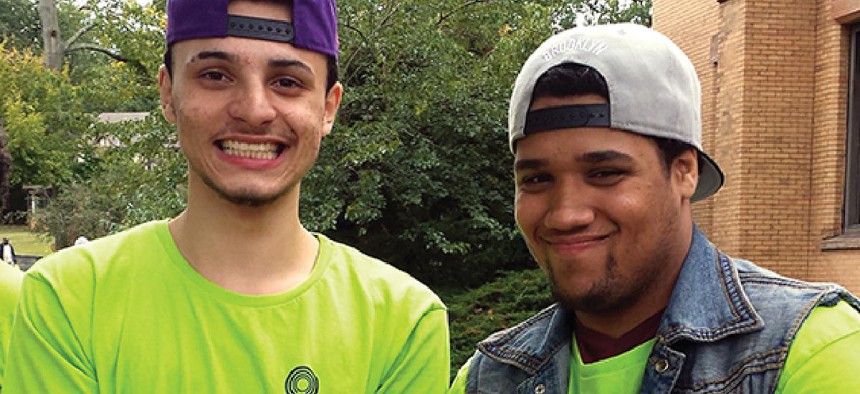Serving Dual-Diagnosed Youth

On a picturesque 33-acre former farm overlooking the Hudson River, some of New York’s most vulnerable adolescents receive comprehensive and structured care from an organization that aims to provide preparation for the staggering lifelong challenges that await them.
At its Residential Treatment Center, the Yonkers-based agency Leake & Watts provides therapeutic and educational support to up to 95 students, ages 12 to 21, who have all too often been neglected, traumatized or unable to access the specialized care they desperately need.
Leake & Watts has recently expanded the services it offers at the Residential Treatment Center to support the special needs of so-called dual-diagnosed youth—those who are classified with a learning disability or emotional disturbance as well as a diagnosed developmental disability, such as an intellectual disability or autism spectrum disorder.
Sue Sampogna, assistant executive director of residential services for the agency, explained that the expansion of services arose from a natural progression.
“Over the summer of 2010, we saw a huge influx of referrals for kids with low IQs and autism spectrum disorders,” Sampogna said. “We decided to provide our staff with training specific for this population, enhanced our programs and even modified our grounds in order to adequately serve this population.”
The vast majority of the center’s residents—85 percent—have been referred by school districts’ special education programs. Several students arrive at the center straight from one of the state’s psychiatric hospitals.
Sampogna says programs like the Residential Treatment Center are essential not only to individuals but to the entire system of school districts, government agencies and hospitals that serve this population.
“From a cost perspective, we are way cheaper than both incarceration and psychiatric hospitals, which is where many of these students would end up otherwise. I can only imagine how traumatic either of those options are for our youth,” Sampogna explained. “We offer these students the option to go to a school that is specifically designed to meet their needs, to play in a pool, and to have many of the typical experiences of childhood that they would not otherwise have access to.”
During their stay at one of eight “cottages” on the center’s campus, students receive individualized academic, recreational and job-skill training instruction, with one staff member for every three students, ensuring that these vulnerable young people experience maximum attention.
Sampogna said the students must undergo an all-encompassing program in order to gain the experience and skills that will be essential for the difficult road ahead.
“We aim to give our students internal controls,” she said. “When they come to us, they are often incredibly impulsive and cannot operate as members of the community. Our programs try to give them the tools that they need to self-regulate.”
Licensed by the state Office of Children and Family Services, the center’s highly structured program includes day school services provided by the on-campus Biondi School, an accredited special education school for grades seven through 12, as well as a host of after-school programs ranging from recreational activities to community volunteering and engagement.
However, the cornerstone of the Residential Treatment Center’s program is its behavior modification curriculum, an evidence-based model called positive behavior intervention and support, or PBIS. This model utilizes a point system to reward and reinforce positive behavior, a concept that Sampogna says is often conspicuously—and unfortunately—absent in these students’ previous experiences.
“These students have often spent their entire lives being told what not to do. We talk to children about what we want to see more of, not what we want to see less of,” Sampogna said.
She says the PBIS system instills in students the values of respect, achievement, safety and responsibility, tenets they must internalize if they are to succeed in the outside world. With these concepts in mind, the program rewards students with increased freedom to leave the grounds, allowances through an employment training program, and a glimpse at what success could look like after their stay at the center.
“I often tell students that as much as I want them to be successful while they are here, I really want them to be successful when they leave,” Sampogna said. “The true goal is to transfer what they learn here into their life in the community.”
The program’s work goes well beyond the scope of the individual student, and helps families navigate the complicated—and often overwhelming—task of providing services for their child, many of whom have already experienced incarceration.
“When families interact with us, it is far from their first experience,” Sampogna said. “They are usually very frustrated with the system. Our task is to figure out how to engage the parents in the process, and to not give up on their kid.”
Twists and turns can come at many stages of a student’s journey to and through the center, given the mountains of paperwork and various agencies that—at least in theory—work in concert to facilitate services.
Sampogna spoke about students who have unnecessarily remained in psychiatric hospitals for months awaiting the processing of requisite paperwork. She cited students whose living situations remain unknown just weeks before they are set to leave the program, due to a lack of appropriate group housing, as well as the slow pace of processing requests. In some cases, Sampogna said, matriculating students who have been unable to secure a place in an Office of Mental Health group home may be forced to land in homeless shelters.
However, Sampogna said, Leake & Watts remains vigilant, continually working to establish relationships with school districts, state psychiatric hospitals and group homes throughout New York in an effort to streamline the process for their clients.
“This type of program, with its specialized cocktail of services, simply did not exist five years ago,” Sampogna said. “Kids had to be placed out of state to receive this kind of help. We saw a rip in the safety net and knew that we needed to mend it.”
NEXT STORY: The Persistent Problem of Pricey Prescriptions
